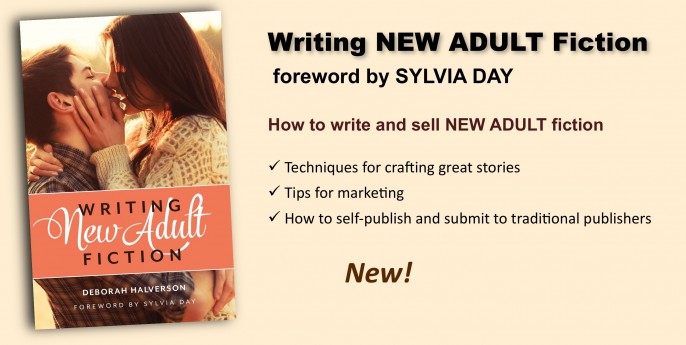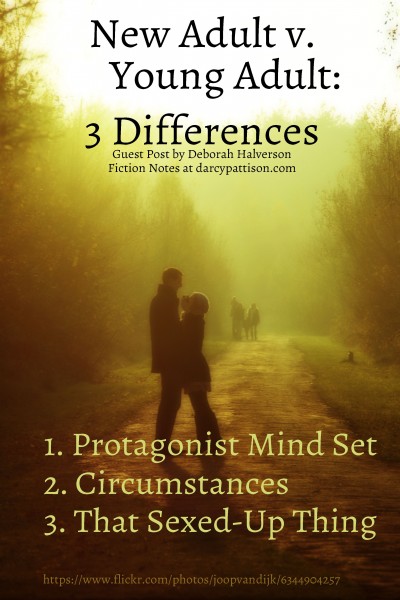In the immortal words of Charlotte in E.B. White’s Charlotte’s Web, “It is not often that someone comes along who is a true friend and a good writer.”
I was privileged to have Deborah Halverson edit my Harcourt picture book, Searching for Oliver K. Woodman. When we met at a retreat, it was instant friendship, and anytime we talk, it feels like we’ve been friends forever. That’s why I am so excited about this new book. Well, I’m excited because it’s Deborah’s book, but also because it’s the first book I’ve seen to explain the latest fiction genre, New Adult. In Deborah’s capable hands, the topic comes alive and I’ve already got tons of ideas for stories. Here, she answers a basic question; but if you want more, you’ve got to buy her book!

Guest post by Deborah Halverson
YA writers often ask me to explain the difference between Young Adult fiction and New Adult fiction when the story’s main character is 18 or 19 years old. Some of those writers are curious about this new fiction category that brushes up against their own, but others are trying to noodle out whether that upper YA story they’re working on is really NA. “Tell me what NA is, Deborah, and then I’ll know what I’ve got.” Happy to help! Here are three ways to determine if you’re writing a story about a young adult or a new adult.
DearEditor.com Deborah Halverson is doing a special giveaway for the blog tour for the kickoff of this book. Enter to win “One Free Full Manuscript Edit!“
Pin Down Your Protagonist’s Mind-set
How does your character process the world and her place in it? Teens are typically starting to look outward as they try to find their places in the world and realize that their actions have consequences in the grander scheme of life, and they yearn to live unfettered by the rules, structure, and identities that have defined their lives until now. New adults finally get to live that free life they dreamed of—for better or worse. They move forward with the self-exploration they began in their adolescence, going big on personal exploration and experimentation and expanding their worldview. They get to build identities that reflect who they’ve become rather than who they grew up with, and they get to try things out before settling into a final Life Plan. All of this can be overwhelming even when it goes well—after all, even good change is stressful, and “change” is new adulthood in a nutshell. For some, though, the instability is a total freak-out. The clash of ideal vs. reality can shock their system. They’re gaining experience and wisdom hand over fist, but yikes. Luckily, new adults tend to brim with personal optimism, and their explorations and experimentations—both dangerous and beneficial—are endearingly earnest.
If this sounds like your protagonist and her circle of friends, you might have an NA on your hands. You can use this knowledge to give your story a solidly NA sensibility by exposing your character’s inexperience in her decision-making, by imbuing the narrative with a sense of defiance, by conveying stress, by conveying self-focus (not selfishness), by lacing the exposition with personal optimism, and by showing the character’s awareness of her growing maturity. YA characters who are overly analytical about themselves and others risk sounding too mature, but NA character journeys ooze with self-assessment no matter the individual details of their journeys.
Assess Your Circumstances
 In fiction, the plot exists to push the protagonist through some kind of personal growth. Thus, our character’s mind-set and the plot are interdependent. Whether your character is a young adult or new adult, the circumstances of your story—the events, problems, places, and roles—should sync with that character. New adults tackle their problems with their new adult filters in place, whether the story is a contemporary one set in college, or a historical one, or a fantastical one. Self-actualization is an essential growth process whether you’re at a college kegger or battling evil overlords.
In fiction, the plot exists to push the protagonist through some kind of personal growth. Thus, our character’s mind-set and the plot are interdependent. Whether your character is a young adult or new adult, the circumstances of your story—the events, problems, places, and roles—should sync with that character. New adults tackle their problems with their new adult filters in place, whether the story is a contemporary one set in college, or a historical one, or a fantastical one. Self-actualization is an essential growth process whether you’re at a college kegger or battling evil overlords.
Once you’ve pinpointed whether your protagonist’s mindset feels YA or NA, consider if your plot events and the circumstances of your protagonist’s life jive with her concerns, fears, coping skills, maturity, and wisdom level. NA story lines tend to remove structure and accountability, tweak the characters’ stress levels by playing musical careers and homes, make money an issue, force the characters to establish new social circles at play and at work, show characters exhibiting ambivalence to adult responsibilities, show characters divorcing from teenhood, show characters striving to “move on from trauma” rather than to “survive trauma”, deny the characters the “ideal” NA life of carefree self-indulgence, put characters in situations that clash their high expectations for independent life against a harsh reality, and show the process of evaluation, of trial-and-error, of weighing exploration and experimentation against consequences, at least by the end of the story.
Deal with the “Sexed-Up YA” Thing
Romance is part of almost any older YA story, and certainly all NA. As it should be—romance is one of the three main areas of identity exploration after puberty, along with career and worldview (think politics, faith, and personal well-being and outlook). The difference is that teens are very solidly in the “what is love, what does it feel like?” realm, whereas new adults are generally working on who they want to be in a relationship, what they want from their partner, what they want from the relationship in general. That doesn’t mean they’re actively searching for Mr./Mrs. Right—there’s plenty of time for that!—but it does mean they want a satisfying, meaningful relationship. Where is your character on that romance spectrum?
Of course, romance isn’t really what people focus on when comparing YA and NA relationships, is it? Nope: it’s sex. So let’s talk about sex. In its early days, NA was accused of being “sexed-up YA”, but after reviewing numbers 1 and 2 above, you’ll see that the differences between YA and NA are more substantial than simply how explicitly you describe two bodies connecting sans clothing. Ask yourself your goal with the romance, and what level of sexual detail is necessary for that goal. Then consider your audience: NA readers are mostly adults of the same 20- to 44-year-old “crossover reader” demographic that shot YA into the publishing stratosphere. (A Digital Book World study reported 2013’s dominant YA crossover readership as being 20- to 29-year-olds; compare that to the 18- to 25-year-old age range of new adulthood). Those grownups can handle—and often flat-out want—explicit sex scenes. Some teens will read NA, but mostly they’re not into that mind-set yet so the stories don’t resonate with them, making them plenty happy to stick with the many great YA stories out there that reflect their current time in life.
Perhaps you determine that your character’s mind-set and story circumstances are solidly YA but you want/need to include some sex scenes in your story because the theme or plot of the story calls for it. In that case, maybe you have a solid YA that requires a “Mature YA” categorization to let readers know that there’s sexual content between those covers. Those scenes will be tamer than the full-on explicitness of NA—your are writing/positioning this story primarily for and about young readers after all, and there are gatekeepers involved—but the sexual content is there and readers are warned. Weigh your goals with your romance, your story’s scene needs, and your audience’s expectations and sensibilities as you make the NA/YA determination on this aspect of your WIP.
So there you have it. Three ways to know if that story you’re writing is Young Adult fiction or New Adult fiction. Good luck with your WIP, and with all your publishing endeavors.
 Deborah Halverson is a veteran editor and the award-winning author of Writing Young Adult Fiction For Dummies. Her latest book, Writing New Adult Fiction, teaches techniques and strategies for crafting the new adult mindset and experience into riveting NA fiction. Deborah was an editor at Harcourt Children’s Books for ten years and is now a freelance editor, the founder of the popular writers’ advice website DearEditor.com, and the author of numerous books for young readers, including the teen novels Honk If You Hate Me and Big Mouth with Delacorte/Random House. For more about Deborah, visit DeborahHalverson.com or DearEditor.com.
Deborah Halverson is a veteran editor and the award-winning author of Writing Young Adult Fiction For Dummies. Her latest book, Writing New Adult Fiction, teaches techniques and strategies for crafting the new adult mindset and experience into riveting NA fiction. Deborah was an editor at Harcourt Children’s Books for ten years and is now a freelance editor, the founder of the popular writers’ advice website DearEditor.com, and the author of numerous books for young readers, including the teen novels Honk If You Hate Me and Big Mouth with Delacorte/Random House. For more about Deborah, visit DeborahHalverson.com or DearEditor.com.
Thank you for trusting me to be helpful to your readers, Darcy. Good luck to all in the giveaway!
Thanks for this! The next story in my writing queue is solidly New Adult in the first two categories (I’m thinking a relationship with a 23-year-old guy who’s trying to get out of a bad first marriage), but I’m not interested in writing explicit sex scenes. I’m not even sure they’d fit the story (small-town America version of Sense & Sensibility). Would that take the story away from NA? Could a story with a 21yo protagonist and no explicit sex find a market?
Great overview of the differences! The mindset is extremely important. NA is not just sexed-up YA with slightly older characters. It explores a new phase of life! Thanks so much for explaining that so concisely in this blog post.
Rochelle–The NA fiction market includes stories without explicit sex scenes. Some readers still like and expect those in their NA purchases, especially when there’s a romantic storyline, but the pendulum seems to be swinging more toward romances that are richly developed and satisfying, with or without explicit sexual content. If you’re not interested/comfortable writing sex scenes, then those scene would probably feel awkward or rushed or in some other way not fully satisfying to fans of those scenes anyway, so trying to include them for the sake of including them would be a misstep. So, while some readers might object to the exclusion of this element, you’ll still have a place in the market.
I’m with you, Heather. Thanks for sharing your thoughts on mindset.